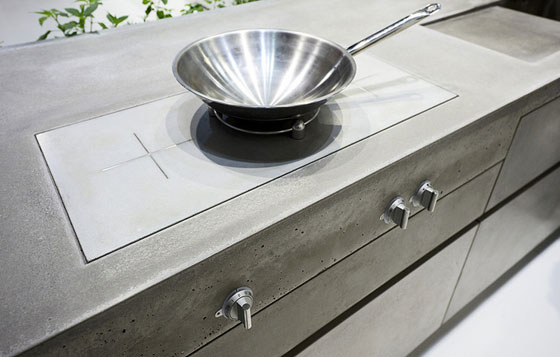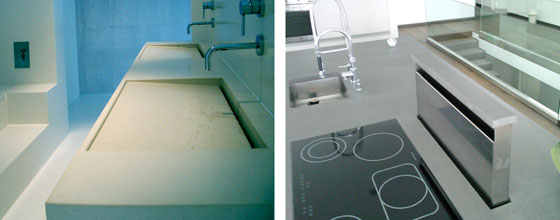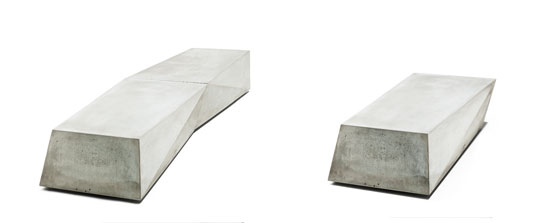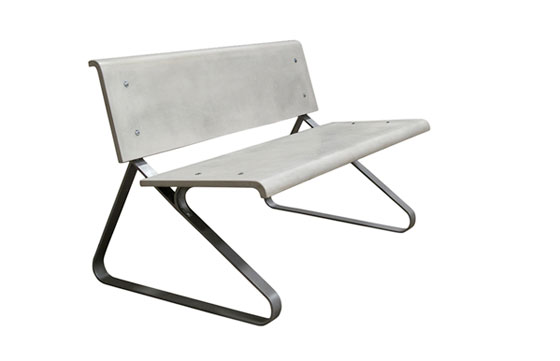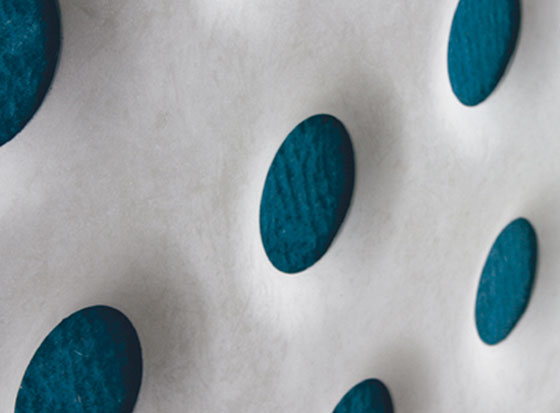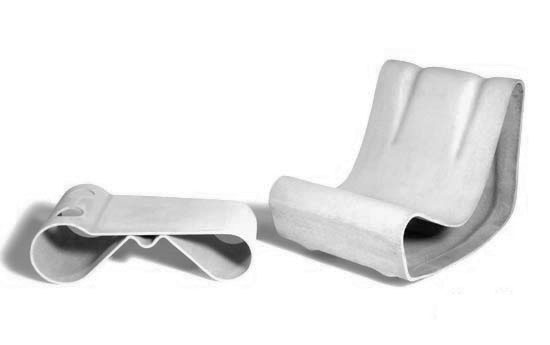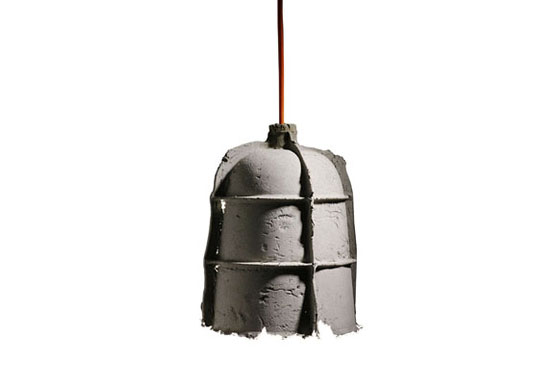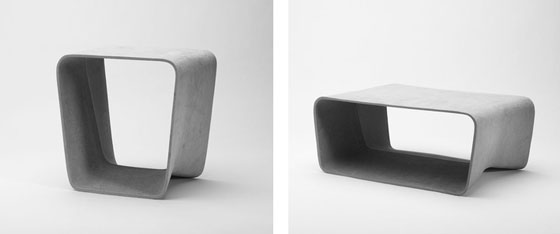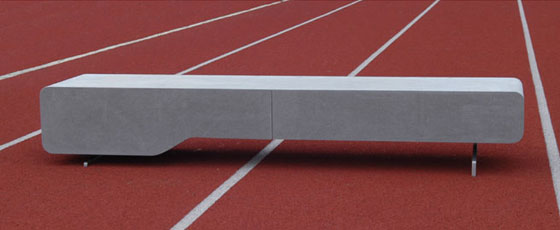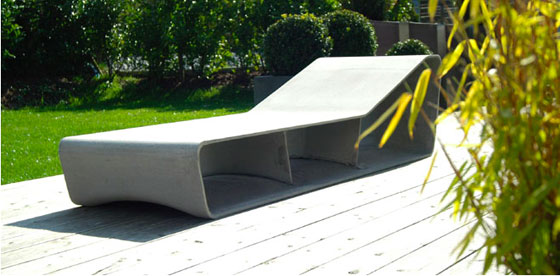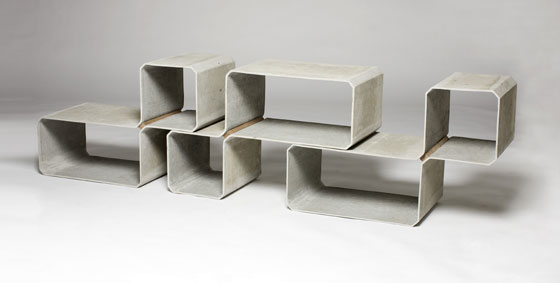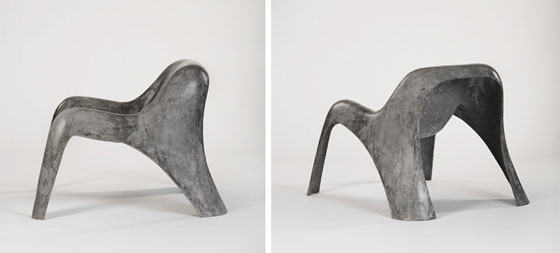Concrete in Architecture (3): Furniture & Objects
Text by Susanne Fritz
Switzerland
18.11.10
In what for the moment will be the last part of our "Concrete in Architecture" series the focus will be on the use of concrete in interior architecture, in particular for creating objects and furniture. .The attraction of concrete as a material is above all its rough surface and the individual forms this can take. In modern architecture this untreated roughness and stony hardness is often contrasted with warm, soft or especially delicate and costly materials.
Kitchen with concrete surfaces by Steininger Design
The chemical process of hydration which enables concrete to harden permits only limited control of the texture of the surface, although chemical additives can be added to influence the porosity, hardening time and flow properties of the concrete. Depending on requirements the surface can also be allowed to develop a patina or protected against the traces of use by impregnation.
Detail of concrete work surface by Steininger Design
The Austrian firm of Steininger Küchen produces an entire kitchen made of concrete. In spite of the fact that the material has a thickness of only 8 mm it is sufficiently light and robust. The precise moulding work required to create the design and the time-consuming treatment of the surfaces by grinding and polishing are all done by hand. An attractive contrast to the concrete surface is formed by the seating area of solid wood and two integrated beds for fresh herbs.
OGGI, the German manufacturer of concrete products such as kitchen worktops, wash basins, planters and mass-produced concrete objects uses a highly versatile form of concrete with an attractive, low porosity surface, the properties of which enable the production of thin-walled concrete articles in a wide variety of designs.
Concrete wash basin und detail of concrete work surface by OGGI
The worktops and washbasins are impregnated, but in spite of this concrete remains a porous material and its seal does not last forever.
In both the kitchen and the bathroom it is generally impossible to avoid the use of substances which are reactive and contain acids: fruit-based acids, vinegar, cleaning agents or contact lens fluid and hair colouring fluids - if possible none of these should come into contact with concrete. Oil does not affect concrete, but it gives it a greasy appearance. At the same time concrete is not scratch resistant, which means that those who opt for utility furniture made of concrete need to be able to put up with the traces left on it by the passage of time and appreciate the patina which is formed.
The Austrian makers of outdoor furniture viteo have, together with the manufacturers Concreto and the designer Gerd Rosenauer, developed the urbane 'Cementum Bloc' seating which, with its sculptural character, can also be applied as a landscape design object.
Bloc is a modular bench system made of two elements which can be combined and is part of the 'Cementum' collection of concrete outdoor furniture.
Stina Lindholm, designer and owner of the Swedish label Skulpturfabriken, works both with solid concrete elements and with thin sheets of fibre-reinforced concrete. The range of her products is correspondingly diverse. Skulpturfabriken combines concrete with natural materials such as felt and wood, which gives a more homely character to objects made of this material, which tends to be rather cold to the touch.
As a material Eternit is not actually concrete but is made of water, air, cement, cellulose and reinforcing fibre. Willy Guhl, who created a design classic with the Guhl Chair which is shaped from a single Eternit panel, did not just catapult Eternit into the standard group of most popular products used by architects - he also freed the company from its negative image as a producer of cheap cladding for facades. The Eternit chair was created in 1954, after Guhl had observed at Eternit AG in Niederurnen how the Eternit panels came out of the machine. The chair consists of a single panel which is produced by a machine and formed into a loop – at the time the streamlined production method made the chair very affordable.
The "Guhl Stuhl" with "Guhl Tisch" by Willy Guhl for Eternit, 1954/2000
In the year 2000 the Guhl Table was added to the Guhl Chair and today Eternit offers an entire furniture collection which is developed by the company together with designers and industrial design students at ECAL.
Eternit in collaboration with ECAL: "Mold" pendant light by Michel Charlot
Eternit in collaboration with ECAL: "Mold" pendant light by Michel Charlot
Eternit in collaboration with ECAL: "ECAL" stool and side table by Nicolas le Moigne
A cooperation with Dominique Haelg, product designer at the Swiss design firm of Labelform, saw the creation of the prize-winning Eternit ES1900 Sideboard, which impresses with its monolithic look, and the Eternit EL 2050 Longchair.
"Eternit ES1900" sideboard by Dominique Haelg/Labelform
"Eternit EL 2050" longchair by Dominique Haelg/Labelform
The design duo Fries & Zumbühl were inspired by the cult game Tetris to create a new modular shelving system. All the individual sections made of 8mm-thick Eternit can be arranged next to, inside or above each other and are held together by connecting elements made of walnut. The result is individual storage space for magazines, books, shoes and other articles. Each TETRIS module is formed by hand in Switzerland and can therefore be identified as an individual piece.
"Tetris" modular shelf by Fries & Zumbühl, in collaboration with Eternit
Thanks to the use of ever more sophisticated reinforcement techniques such as carbon fibre statically daring paper-thin designs are now possible, as the furniture produced by the firm of Paulsberg shows. The Paulsberg Couch seems to have an almost impossible width of span, while the shiny polished surface of the Paulsberg collection is also fascinating.
The attraction of concrete as a material in furniture and product design lies in the emphasis on its weight and massiveness, which is expressed in the block-like monolithic designs which have been presented here. It is also expressed in contradictory applications which stretch its physical and static properties to their limit, and in emphasising the elegance and filigree nature of this apparently rough and unwieldy material. What fascinates us about it is the way it demonstrates that things which seem to be impossible are in fact quite possible. On the other hand there is nothing impossible about lamps made of concrete, as Architonic as already shown in its article "Petrified light: the five best lamps made of concrete". Why not see for yourself!


